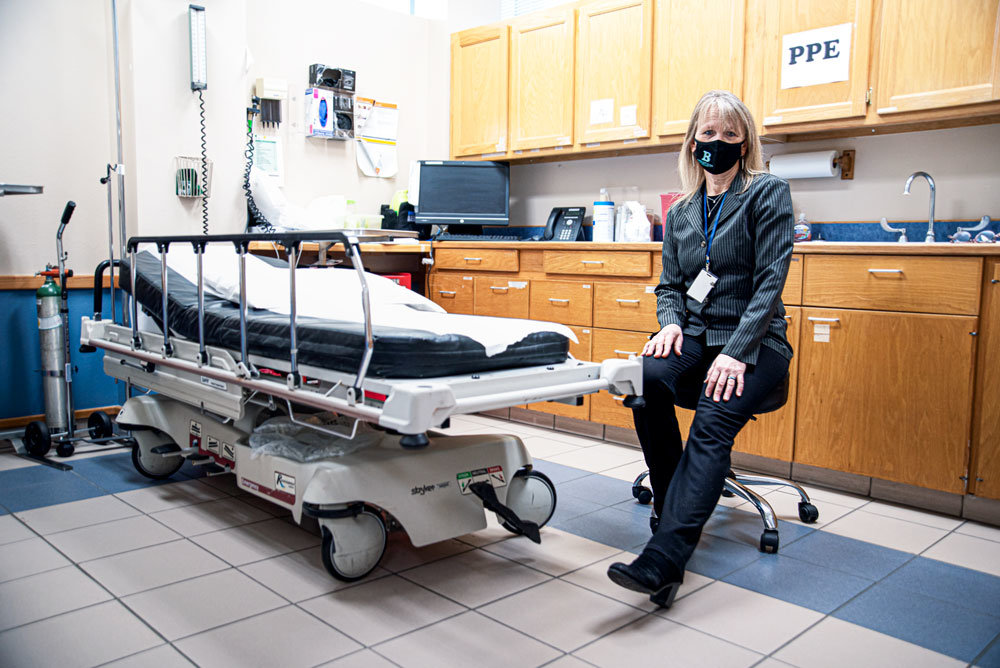YOUR BUSINESS AUTHORITY
Springfield, MO
YOUR BUSINESS AUTHORITY
Springfield, MO

Amid the coronavirus pandemic’s far-reaching impact, leadership at Fordland Clinic Inc. says 2020 has been a challenging year unlike any other.
Joan Twiton, CEO of the Fordland-based federally qualified health center, says COVID-19 tests have been administered to patients weekly since July. The 501(c)(3) nonprofit provides medical, dental and behavioral health services at its two clinics in Fordland and Kimberling City.
“We were just getting a lot of calls throughout the week of people looking to get tested,” Twiton says, noting the two clinics initially held several one-day testing events. “We decided rather than putting all our resources into having these events, we would just start to have testing on a regular basis at both clinics.”
The COVID-19 tests have ramped up in recent months, says registered nurse Amy Whiteside, one of Fordland Clinic’s 54 employees. Roughly 115 people are now being tested weekly between the two sites, she says. Around 300 have tested positive.
“We end up closing testing most of the time, only filling the slots that we have. That’s only because we could literally reach the point that we’d test all day,” she says.
Whiteside says clinic staff members have advised many of those who’ve tested positive for COVID-19 because a lot of them don’t have a primary care physician.
“We feel like someone needs to give them guidance,” she says. “Even if they’re not our patient, they need access to someone who is going to help.”
The pandemic slowed the patient count this year for the nonprofit, which generally sees around 5,000 people annually in Fordland and 3,000 in Kimberling City, Twiton says. The patients combined for around 22,000 visits in 2019. She expects a patient visit decline of 35% in 2020, primarily due to limited dental services.
“We really do reach a lot of the community around the Highway 60 corridor,” Twiton says, noting the Fordland center primarily draws patients from Webster County.
Fordland Clinic started in 1996 in a small building on Main Street in the southern Webster County town of roughly 850 residents, says Twiton, a 20-year employee who became CEO in 2017. It moved in 2001 to its current Fordland building and added dental services in 2006. The Kimberling City clinic, which mostly serves residents of Stone and Taney counties, opened in 2012. Between the two clinics, the health center employs two physicians, four nurse practitioners, two dentists and two mental heath providers, she says.
The nonprofit ended 2019 with $5.3 million in revenue, up roughly 10% year-over-year, Twiton says. Because of pandemic conditions, 2020 is projected at a loss of $415,000, she says, noting the financial drop is cushioned some by Coronavirus Aid, Relief and Economic Security Act funding.
According to the Health Resources and Services Administration, Fordland Clinic received over $676,000 in CARES Act funds this year as part of nearly $28 million distributed to 29 health centers in the state.
“These dollars coming in has made a huge difference,” Twiton says. “It’s also enabled us to respond the way that we are with COVID testing.”
Partnering up
To bolster its mental health services, Fordland Clinic forged a partnership in 2019 with Burrell Behavioral Health.
“They’re interested in having primary care for their patients just as we’re interested in expanding our behavioral health for our patients,” Twiton says.
Dustin Brown, vice president of integration with Burrell, says five employees provide services, including telehealth, in Fordland and Kimberling City. In exchange, Twiton says Fordland Clinic offers primary care services two days a week in Springfield.
Brown estimates up to 50% of Burrell’s clients don’t have access to primary care physicians upon first visiting the behavioral health provider.
“Two of the cornerstones of Burrell’s mission are to increase access to behavioral health care out in our community, but it’s also to cover gaps in care internally,” Brown says. “The Fordland partnership has really helped us to do both.”
Building investment
As a federally qualified health center, Fordland Clinic – and its counterpart in Springfield, the Jordan Valley Community Health Center – receives federal funds to provide primary care services in underserved areas, according to HRSA that governs the centers. A governing board that includes patients guides the centers.
“You are getting input from people who receive your services on a regular basis to help you determine what additional services you need to be providing, what you need to improve on,” Twiton says.
The nonprofit has been physically growing in Fordland. The Barton Drive building has nearly doubled to 9,000 square feet in the past five years. It added dental rooms and a conference space in 2015, Twiton says, through a $500,000 Neighborhood Assistance Program grant by the Missouri Department of Economic Development. A $400,000 NAP grant in 2016 funded more medical exam rooms, a nurses’ station and administrative offices.
Another addition is in the plans for 2021. Fordland Clinic received a $1 million Capital Assistance for Disaster Response and Recovery Efforts grant this year through HRSA, Twiton says. The money will fund expansion of the reception area, and add patient bathrooms and behavioral health rooms. Lobby seating capacity will expand to 60 from 15.
“That will take a lot of resources and staff time,” she says, noting alternative patient access points are under consideration. “That will be a challenge.”
But Twiton says stretching its footprint beyond Fordland and Kimberling City isn’t in the nonprofit’s foreseeable future.
“We’re always open to new areas and ideas, but at this point we’re focusing on doing the expansion,” she says.
Delta Roofing founder dies at 85
Cox College switching leaders ahead of Alliance for Healthcare Education transition
Curb Appeal: 23 high-end homes hit market
'Civil War' opens at No. 1 at domestic box office
Four arrested over theft of $300K in Lego kits